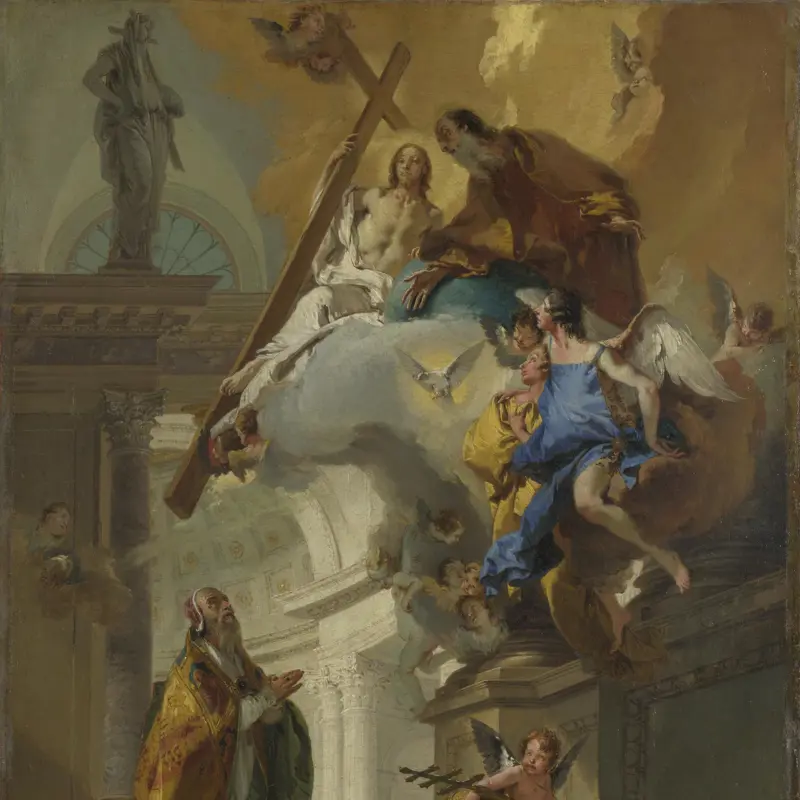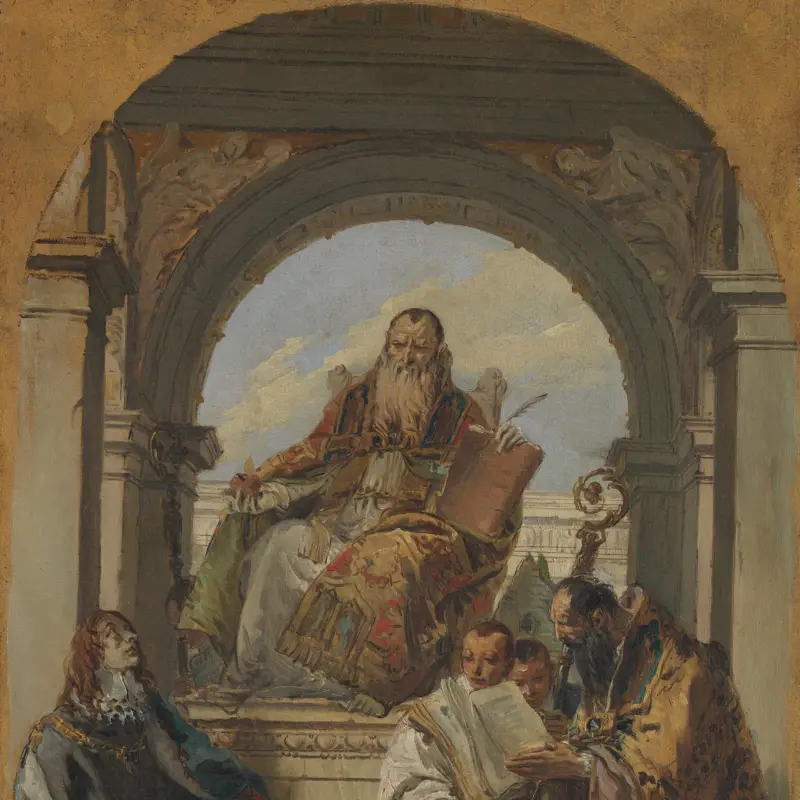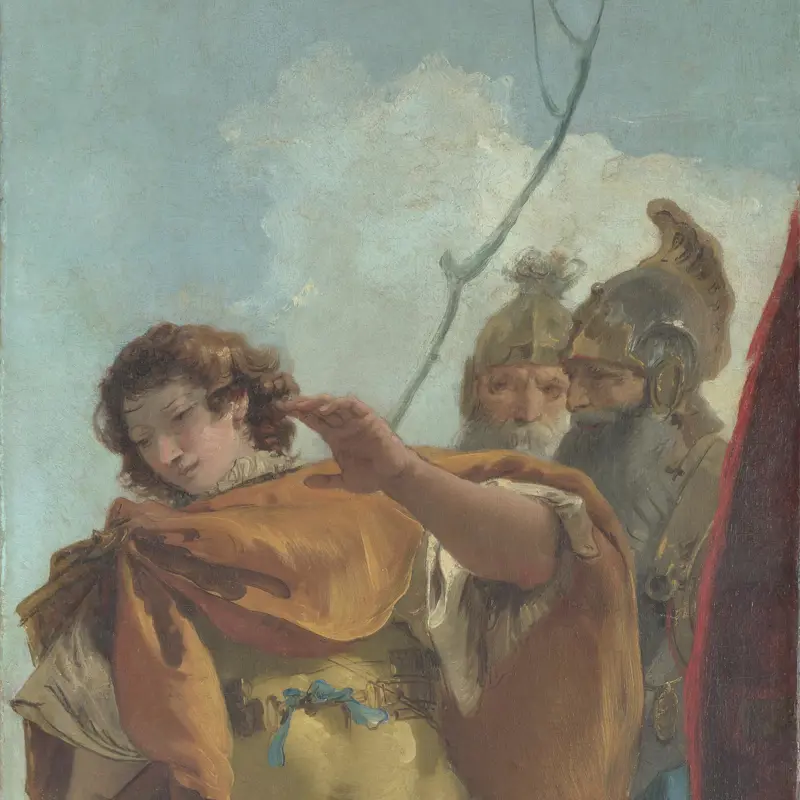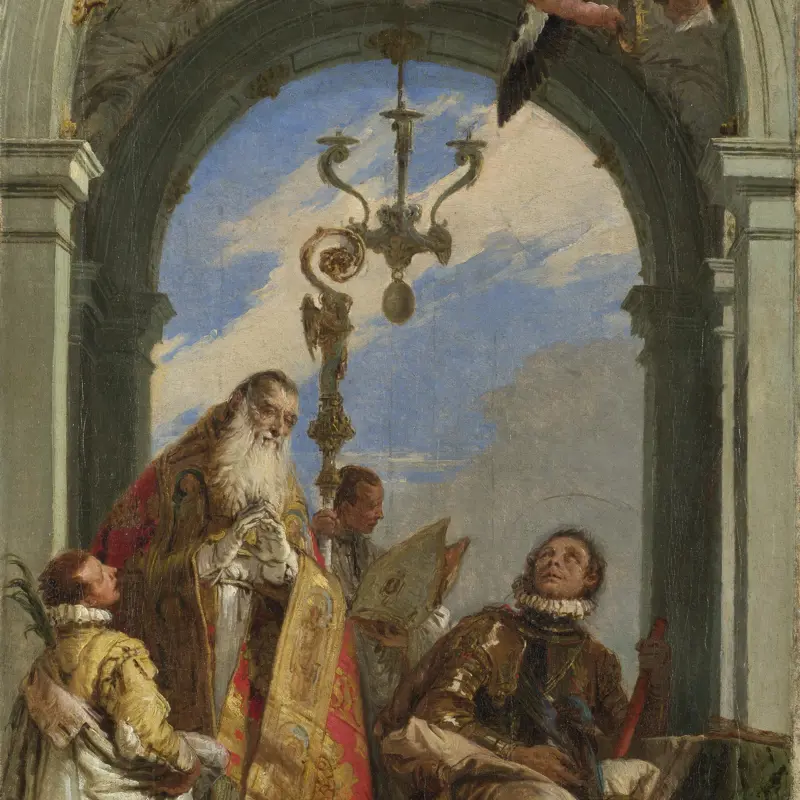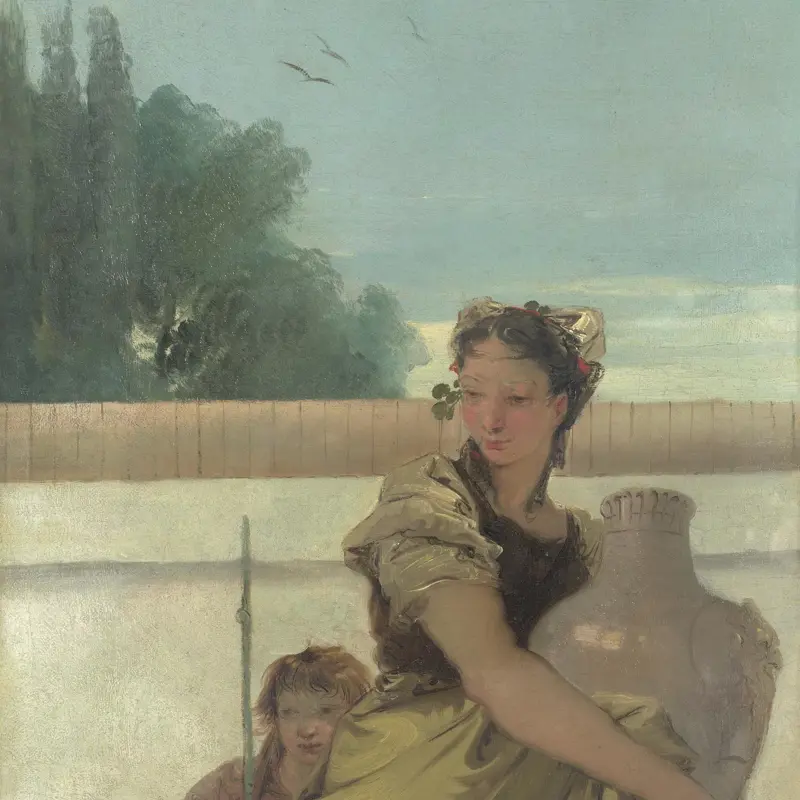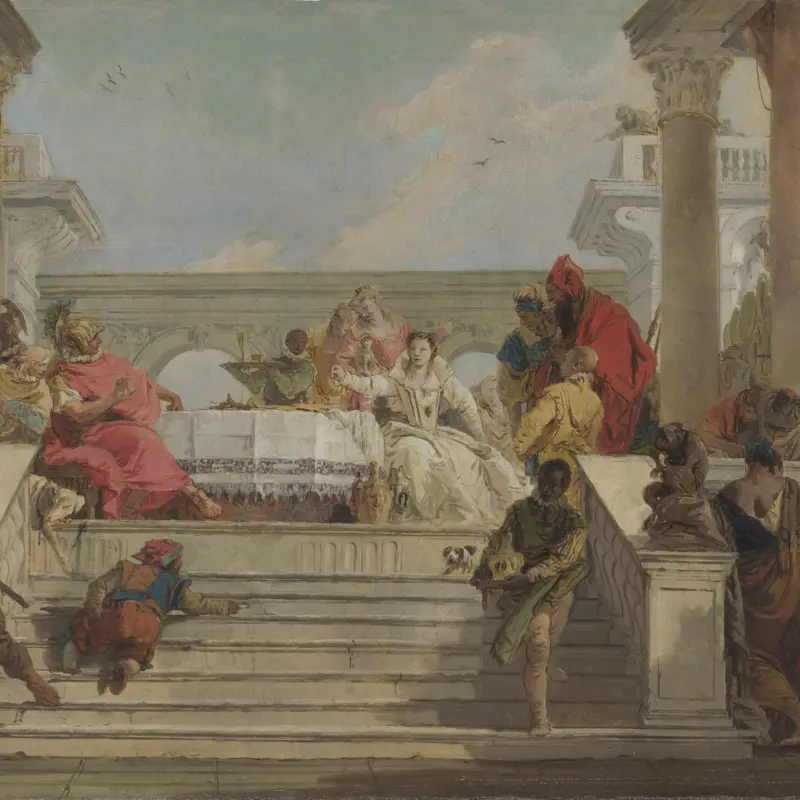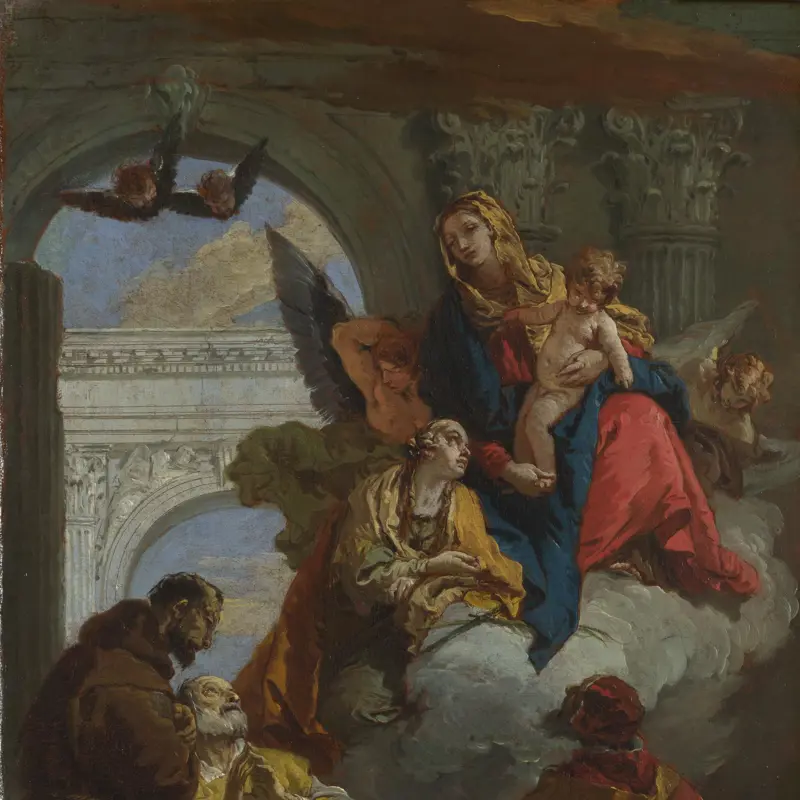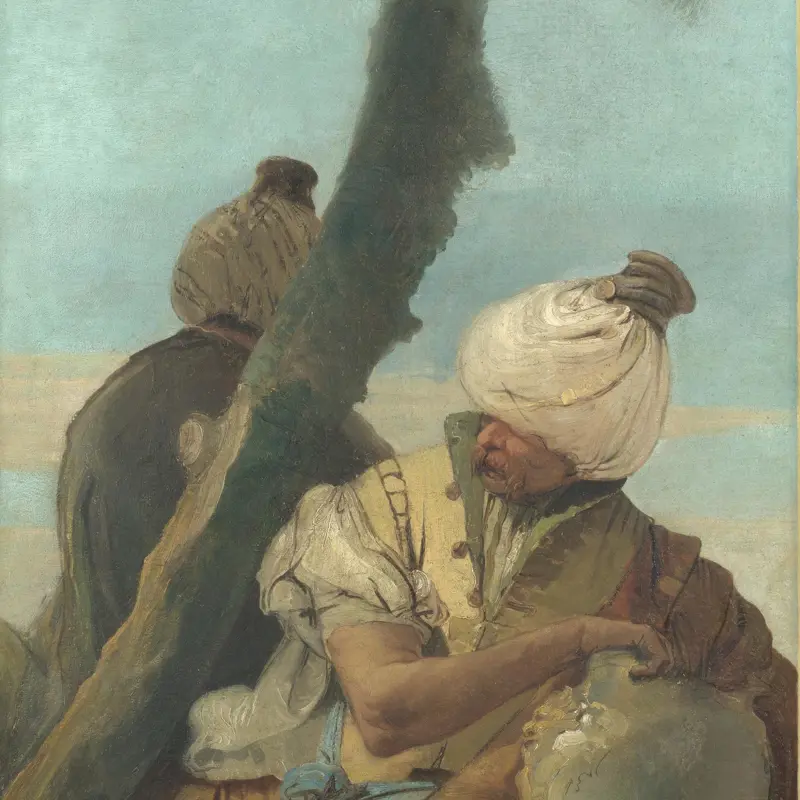Giovanni Battista Tiepolo, 'An Allegory with Venus and Time', about 1754-8
About the work
Overview
This huge oval-shaped painting, which is about 3 metres long, was commissioned to decorate a ceiling in a palazzo belonging to the Contarini family. The scale of the figures and the sense that they are above us hint at the intended destination: this work was made to be seen from below, and at a great distance.
The imagery suggests it was made to celebrate a new heir. Venus, the goddess of love and fertility, gestures lovingly towards an infant, who is held by a winged figure – a personification of Time, who has here laid aside his scythe. The act symbolises immortality, although the hourglass at his waist suggests the inevitable passing of time. In the clouds above, the Three Graces bless the child by scattering flowers.
Tiepolo’s characteristic loose handling of paint can be seen in Time’s feathery wings, and his delicate colouring in Venus' pale flesh and striking pink drapery, in contrast with Time’s brown skin and brilliant blue loincloth.
Audio description
Listen to an audio description of Giovanni Battista Tiepolo's 'An Allegory with Venus and Time'
Transcript
This is a description of 'An Allegory with Venus and Time' by Giovanni Battista Tiepolo, painted around 1754 to 1758. It is an oil painting on canvas, designed to be installed on a ceiling.
Today, this impressively large, oval-shaped painting is displayed vertically on a wall. It is almost three metres high, and nearly two metres across, with a narrow frame. However, to give a sense of how it would have looked on a ceiling, the upper part is tipped forwards, so the painting is angled down towards us.
The scene depicts a view of a sunlit sky, with the curve of a blue-green globe at the lowest edge. A stepped sequence of robust clouds, starting dark, becoming lighter, climb up to crisp blue sky. Nude figures are perched on them, swathed in fine drapery.
The picture is an allegory, the figures inspired by classical mythology representing abstract concepts, such as love and time. The main focus of the painting is centre left, where a pale-skinned, female nude sits in splendour on a cloud, upon sugary pink silk. More silvery grey silk is draped over her lap. She is Venus, Goddess of Love and Beauty. Her dark blonde hair is swept back from a smooth forehead. There are pearls around her throat, and an elegant twist through her youthful body: legs bent at the knee and falling to the left, her bare torso and breasts face front. Above her, the curved wheel of a golden chariot is partly visible in a cloud. Above that, on the right, three female nudes huddle on a cloud. These are The Three Graces, arms raised to scatter flowers.
Venus is looking down and to the right, following the line of her outstretched arm, towards the shadowy figure on the cloud below. Here sits a withered elderly male, with a long grey beard, looking up at Venus. He is nude, apart from the folds of blue and gold silk covering his loins and one of his legs. His large grey wings are raised behind his back. He represents Time, and he has a sand-timer tied to his waist, resting on the cloud behind him. On his lap, his bony hands cradle a baby who looks directly out at us. Venus is reaching down towards this newborn child, her fingers seeming to gently touch its head.
Time has set down his sythe. The handle has pierced the dark cloud below him, and its curved blade protrudes from the bottom. Nearby, the winged figure of an infant Cupid clutches his red quiver of love arrows.
At the very top of the painting, against the clear blue sky, two white doves join beaks, in what looks like a lover’s kiss.
This painting was intended to delight and add a flourish of decorative fancy to a grand Italian palace belonging to the Contarini family, possibly to celebrate the birth of a child. The new born sitting on the lap of the elderly Time, might be the mythological hero Aeneus, who was granted immortality. However, with a distinctive face, it could also be a portrait of a young Contarini heir. The allegory reminds us of the inevitable passage of time, and the shared desire for each new baby to have a long and prosperous life.
Key facts
Details
- Full title
- An Allegory with Venus and Time
- Artist
- Giovanni Battista Tiepolo
- Artist dates
- 1696 - 1770
- Date made
- about 1754-8
- Medium and support
- oil on canvas
- Dimensions
- 292 × 190.4 cm
- Acquisition credit
- Bought with a special grant and a contribution from The Pilgrim Trust, 1969
- Inventory number
- NG6387
- Location
- Room 33
- Collection
- Main Collection
- Frame
- 20th-century Replica Frame
Provenance
Additional information
Text extracted from the ‘Provenance’ section of the catalogue entry in Michael Levey, ‘National Gallery Catalogues: The Seventeenth and Eighteenth Century Italian Schools’, London 1986; for further information, see the full catalogue entry.
Exhibition history
-
2018Venice at Vivaldi and Tiepolo's TimePalazzo Ducale (Venice)23 February 2019 - 9 June 2019
Bibliography
-
1971The National Gallery, The National Gallery: January 1969 - December 1970, London 1971
-
1986Levey, Michael, National Gallery Catalogues: The Seventeenth and Eighteenth Century Italian Schools, London 1986
-
2001
C. Baker and T. Henry, The National Gallery: Complete Illustrated Catalogue, London 2001
About this record
If you know more about this work or have spotted an error, please contact us. Please note that exhibition histories are listed from 2009 onwards. Bibliographies may not be complete; more comprehensive information is available in the National Gallery Library.

